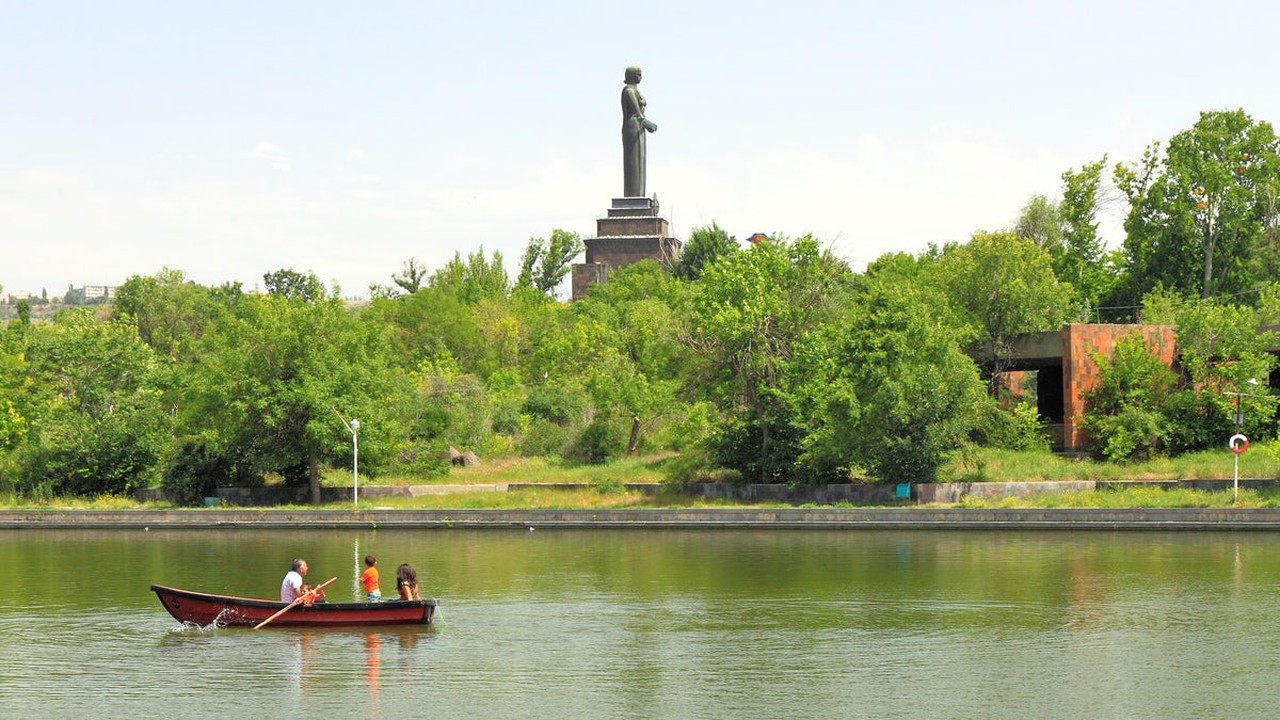SQUARES AND PARKS

Architect: Rafael Israelyan
Sculptor:
Ara Harutyunyan
Located at 2 Azatutyun Avenue, in the recessed right section.
The construction of Arabkir City Park began in the late 1930s. After the
Great Patriotic War, it was renamed Victory Park, where the Victory Memorial
Complex was to be established.
The project for the reconstruction of the park and the creation of the
memorial complex was designed by architect Rafael Israelyan. Over the years,
hundreds of trees were planted in the empty area, creating a forested zone.
The Victory Park Memorial Complex with the statue of Joseph Stalin
(height: 17 m) was opened on November 29, 1950, on the 30th anniversary of the
Sovietization of Armenia. The author of Stalin's statue is sculptor Sergey
Merkurov, and the sculptured pedestal is by Rafael Israelyan. Because of the
statue, Yerevan residents still call the complex, park, and neighborhood “Monument.”
From the main entrance, a wide alley leads to the Victory Monument, from
the front square of which opens a panorama of the city. An iron fence was built
along the square (architect: Rafael Israelyan). The Victory Memorial Complex is
the Armenian people’s tribute to their compatriots who died in the war.
Stalin’s statue remained on the pedestal for more than a decade. After
the criticism of the cult of personality, in 1962, Stalin’s statue was
dismantled, and years later, Ara Harutyunyan’s “Mother Armenia” statue (height:
22 m) was installed on the pedestal as a collective image of the Armenian woman
defending the motherland. Inside the three-story pedestal, since 1970, the
museum “Armenia in the Great Patriotic War 1941-1945” has been operating, which
was renamed in 1995 to “Mother Armenia” Military Museum. It displays exhibits
related to the Great Patriotic War and the Artsakh Liberation War and hosts
various events.
Victory Park, with its initial area of 110 hectares, has always been one
of the favorite places for rest and leisure for Yerevan residents, especially
young people, with its various carousels, artificial lake, and playgrounds. The
first carousel was installed in the park in 1955-1956. Lake Arevik was built
between 1958-1961. It replicates the outline of Lake Sevan and has a depth of
up to 8.5 meters. Here, one could both swim and go boating. Pavilions and other
light structures were also built according to the design of architect Hovhannes
Hakobyan. In 1967, the first Ferris wheel carousel was installed in the park -
the “Chertovoe koleso” (Devil’s Wheel) loved by Yerevan residents, and the
second one in 1989.
The “Aragil” (Stork) restaurant, designed by Rafael Israelyan in 1957,
is located in the park area. It is built with a combination of white felsite
and ochre-colored tuff from Ani, perched like an auspicious bird on the heights
of Kanaker. The sculptor of the stork is master stonemason and jeweler Hrach
Stepanyan. Some scenes from the Armenian film “Road to the Circus” (1963) were
shot here. The restaurant, which was crowded during Soviet times, is now
half-ruined and abandoned.
In 1977, the sculpture “No to War” (“May There Never Be War”) was
erected (architect Felix Zargaryan, sculptor Vahan Khachikyan).
Between 1983-1985, reconstruction work was carried out in the park and
memorial complex area (architects Ashot Aleksanyan, Anahit Navasardyan). The
Alley of Heroes was built, and the Tomb of the Unknown Soldier with its eternal
flame, originally created in 1970 by Rafael Israelyan, was reconstructed. The
opening took place on May 9, 1985, on the 40th anniversary of the Great
Victory.
The main entrance to the park is designed as a triumphal arch and has
unique bas-reliefs. The western wall along the avenue is built with brown tuff,
with diamond-shaped stones. It was constructed in 1983, designed by Rafael
Israelyan.
In the 1990s, when the newly independent third republic of Armenia was
under blockade and faced heating problems, like many parks in Yerevan, trees in
Victory Park were cut down, areas became deserted, and later city authorities
sold them. Now it is a residential area with luxurious mansions. Although tree
planting efforts were made later (for example, in March 2013 near the Alley of
Heroes and “Aragil” restaurant), the loss of the forest could not be restored.
In 2011, the park was reconstructed under the sponsorship of Moscow-based benefactor Ruben Vardanyan and according to a plan developed by the American company “Gary Goddard.”
“Scientific Research Centre of Historical and Cultural Heritage” SNCO
Yerevan Municipality












